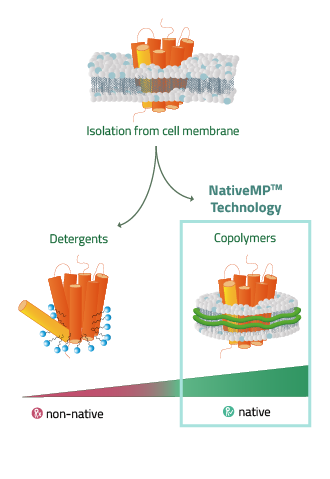Toll-like receptor 5 (TLR5, TIL3)
Order number: 70071
Description
We are pleased to introduce our off-the-shelf, full-length, active, and native Toll-like Receptor 5 (TLR5, TIL3). TLR5 is a vital component of the innate immune system, responsible for recognizing bacterial flagellin and triggering immune responses. Its role is significant in various diseases, including inflammatory bowel disease, rheumatoid arthritis, bone loss, and certain cancers, where immune dysregulation can lead to chronic inflammation or tumor progression.
Our TLR5 protein has been solubilized and stabilized using Cube Biotech's NativeMP™ platform, ensuring that it maintains its native structure and full biological activity. This makes it an excellent choice for diverse research applications.
Applications:
- Screening/Validation
- Biologics Development
- Structure Determination
- Small Molecule Drug Development
The protein delivered can be utilized for these specific applications. When ordering, please specify which applications you intend to use the protein for in the contact form to ensure the best results.
For more details, explore our solubilization database.
Cube’s NativeMP™ Platform enables high-resolution structural studies with compounds and allows assays to be conducted at body temperature, saving valuable time in your research efforts.

Datasheets
Upon ordering, you will receive the corresponding datasheets and the Certificate of Analysis (CoA).
| Feature | |
|---|---|
| Alternative names | TLR5, TIL3 |
| UniProt Number | O60602 |
| Protein class | Receptor |
| Organism | Homo sapiens |
| Sequence, One-Letter Code | MGDHLDLLLGVVLMAGPVFGIPSCSFDGRIAFYRFCNLTQVPQVLNTTERLLLSFNYIRTVTASSFPFLEQLQLLELGSQYTPLTIDKEAFRNLPNLRILDLGSSKIYFLHPDAFQGLFHLFELRLYFCGLSDAVLKDGYFRNLKALTRLDLSKNQIRSLYLHPSFGKLNSLKSIDFSSNQIFLVCEHELEPLQGKTLSFFSLAANSLYSRVSVDWGKCMNPFRNMVLEILDVSGNGWTVDITGNFSNAISKSQAFSLILAHHIMGAGFGFHNIKDPDQNTFAGLARSSVRHLDLSHGFVFSLNSRVFETLKDLKVLNLAYNKINKIADEAFYGLDNLQVLNLSYNLLGELYSSNFYGLPKVAYIDLQKNHIAIIQDQTFKFLEKLQTLDLRDNALTTIHFIPSIPDIFLSGNKLVTLPKINLTANLIHLSENRLENLDILYFLLRVPHLQILILNQNRFSSCSGDQTPSENPSLEQLFLGENMLQLAWETELCWDVFEGLSHLQVLYLNHNYLNSLPPGVFSHLTALRGLSLNSNRLTVLSHNDLPANLEILDISRNQLLAPNPDVFVSLSVLDITHNKFICECELSTFINWLNHTNVTIAGPPADIYCVYPDSFSGVSLFSLSTEGCDEEEVLKSLKFSLFIVCTVTLTLFLMTILTVTKFRGFCFICYKTAQRLVFKDHPQGTEPDMYKYDAYLCFSSKDFTWVQNALLKHLDTQYSDQNRFNLCFEERDFVPGENRIANIQDAIWNSRKIVCLVSRHFLRDGWCLEAFSYAQGRCLSDLNSALIMVVVGSLSQYQLMKHQSIRGFVQKQQYLRWPEDLQDVGWFLHKLSQQILKKEKEKKKDNNIPLQTVATISGSSGTETSQVAPA |
| Affinity tags | Rho1D4-tag (C-terminal) |
| Size (excluding additional elements) | 858 amino acids, 98 kDa |
| Concentration | 0.4 - 0.7 mg/ml (forms Homodimers) |
| Purity | >90%, determined via SDS-PAGE |
| Purification process | 2-step purification |
| Shipping | Shipment is carried out on dry-ice for temperature stability to ensure the integrity of the product. |
| Function | Pattern recognition receptor (PRR) located on the cell surface that participates in the activation of innate immunity and inflammatory response (PubMed:11323673, PubMed:18490781). Recognizes small molecular motifs named pathogen-associated molecular pattern (PAMPs) expressed by pathogens and microbe-associated molecular patterns (MAMPs) usually expressed by resident microbiota (PubMed:29934223). Upon ligand binding such as bacterial flagellins, recruits intracellular adapter proteins MYD88 and TRIF leading to NF-kappa-B activation, cytokine secretion and induction of the inflammatory response (PubMed:20855887, PubMed:11489966). Plays thereby an important role in the relationship between the intestinal epithelium and enteric microbes and contributes to the gut microbiota composition throughout life (By similarity). {ECO:0000250|UniProtKB:Q9JLF7, ECO:0000269|PubMed:11323673, ECO:0000269|PubMed:11489966, ECO:0000269|PubMed:18490781, ECO:0000269|PubMed:20855887, ECO:0000269|PubMed:29934223}. |
| PubMed ID | 9596645, 18810425, 19179655, 19924287, 16710414, 15489334, 9435236, 15340161, 11489966, 11323673, 16027372, 17157808, 17442957, 18490781, 20855887, 23447684, 24778236, 29934223, 22173220, 14623910 |
Lab Results






